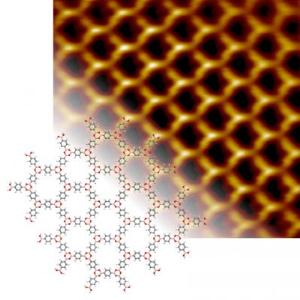
Even the costliest oriental carpets have small mistakes.
It is said that pious carpet-weavers deliberately include tiny mistakes in their fine carpets, because only God has the right to be immaculate.
Molecular carpets, as the nanotechnology industry would like to have them are as yet in no danger of offending the gods.
A team of physicists headed by Dr. Markus Lackinger from the Technical University of Munich (TUM) und Professor Thomas Bein from the Ludwig-Maximilians-University Munich (LMU) has now developed a process by which they can build up high-quality polymer networks using boron acid components.
The "carpets" that the physicists are working on in their laboratory in the Deutsches Museum Munich consist of ordered two-dimensional structures created by self-organized boron acid molecules on a graphite surface. By eliminating water, the molecules bond together in a one-atom thick network held together solely by chemical bonds - a fact that makes this network very stable. The regular honey-comb-like arrangement of the molecules results in a nano-structured surface whose pores can be used, for instance, as stable forms for the production of metal nano-particles.
The molecular carpets also come in nearly perfect models; however, these are not very stable, unfortunately. In these models the bonds between the molecules are very weak - for instance hydrogen bridge bonds or van der Waals forces. The advantage of this variant is that faults in the regular structure are repaired during the self-organization process - bad bonds are dissolved so that proper bonds can form.
However, many applications call for molecular networks that are mechanically, thermally and/or chemically stable. Linking the molecules by means of strong chemical bonds can create such durable molecule carpets. The down side is that the unavoidable weaving mistakes can no longer be corrected due to the great bonding strength.
Markus Lackinger and his colleagues have now found a way to create a molecular carpet with stable covalent bonds without significant weaving mistakes. The method is based on a bonding reaction that creates a molecular carpet out of individual boron acid molecules. It is a condensation reaction in which water molecules are released. If bonding takes place at temperatures of a little over 100 C with only a small amount of water present, mistakes can be corrected during weaving. The result is the sought after magic carpet: molecules in a stable and well-ordered one-layer structure.
Markus Lackinger's laboratory is located in the Deutsches Museum Munich. There he is doing research at the Chair of Prof. Wolfgang Heckl (TUM School of Education, TU Munich). Prof. Bein holds a Chair at the Department of Chemistry at the LMU. The research was conducted in collaboration with Prof. Paul Knochel's work group (LMU) and Physical Electronics GmbH, with funding by the Excellence Cluster Nanosystems Initiative Munich (NIM) and the Bavarian Research Foundation (BFS).
Further Information:
Jurgen F. Dienstmaier, Alexander M. Gigler, Andreas J. Goetz, Paul Knochel, Thomas Bein, Andrey Lyapin, Stefan Reichlmaier, Wolfgang M. Heckl and Markus Lackinger:
Synthesis of Well-Ordered COF Monolayers: Surface Growth of Nanocrystalline Precursors versus Direct On-Surface Polycondensation.
In: ACS Nano; 2011, 5 (12), pp 9737 - 9745, DOI 10.1021/nn2032616
Source: Technical University of Munich, Germany
Last update: 10.01.2012
Perma link: https://www.internetchemistry.com/news/2012/jan12/boron-acid-networks.php
More chemistry: index | chemicals | lab equipment | job vacancies | sitemap
Internetchemistry: home | about | contact | imprint | privacy
© 1996 - 2023 Internetchemistry
